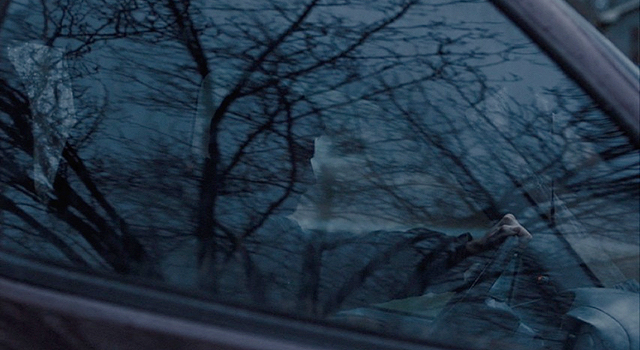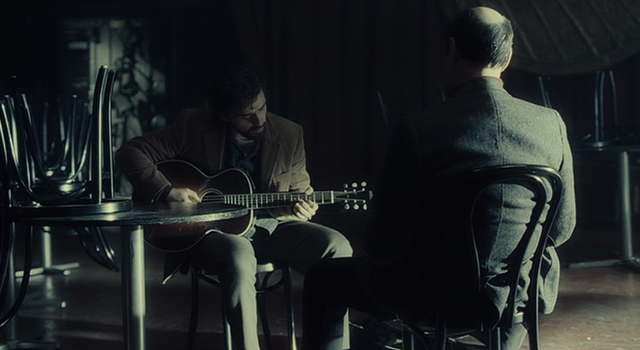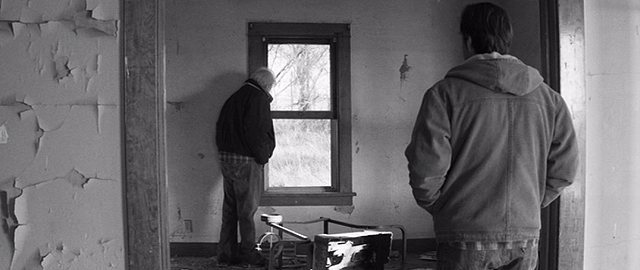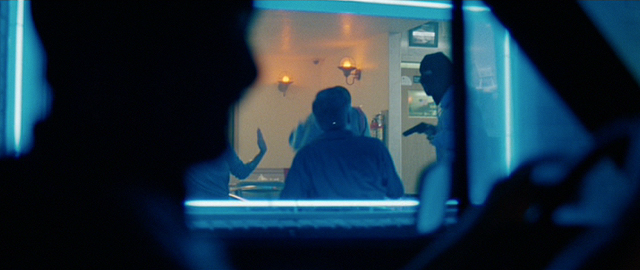
If you look here and there on the web these days, you might notice that more than a few outlets are now cooking up their own “top 10 shots of the year” pieces. Here we are in our seventh year of producing such a collective, but imitation is flattery, and frankly, I'm glad others have caught on to the idea. Singular images and the thematic impact they make are as subjective as anything else we end up praising at the end of a given year, so having separate takes on the matter is only a good thing.
But I'm also confident in the value of what we have to offer on the subject every year, which is a unique take on the specific images chosen from the horses' mouths: the cinematographers themselves. An aside on that…
Late last year, the International Cinematographers Guild saw fit to hand me a pretty trophy in recognition not just of the work I put into these kinds of pieces throughout the year, but our coverage of the craft of cinematography in general in this space. It was a huge honor, one that couldn't have meant more coming from anyone else, honestly. The idea that there's a level of appreciation for the spotlight we shine below the line is as gratifying as anything in my work over the years.
In acceptance, I made it clear that they were basically handing me an award for having a blast. Because I truly relish the opportunity to get on the phone with people like Roger Deakins, Sean Bobbitt, Masanobu Takayanagi, the late Harris Savides, Wally Pfister, Bob Richardson and more this time of year, to pick their brains, to discuss their work and to boil down their thoughts on this and that film to that most singular, cellular of elements: the film frame.
Sometimes, of course, it's more than just one frame. Sometimes it's a drawn-out composition that digs in and stays. Other times, it's a clever move of the camera that dazzles or immerses. Whatever the case may be, the heart of this annual piece is an examination of how what we see on the screen informs the greater impact of a film, how what a DP captures through that aperture becomes the essence of our passion and how the resulting, indelible imagery stays with us as an everlasting footprint revealing the soul of a work of art.
So, as it pertains to this space, “The Top 10 Shots of the Year” is a reflection on the most significant, though perhaps not always the most obvious, visual elements of a film year. And 2013 had plenty of wonders to offer – so many, in fact, that the density of quality seen elsewhere in this competitive awards season played itself out on the ballots of the American Society of Cinematographers, as a tie led to seven feature film nominees rather than the usual five.
How did all of that boil down in my own little image diary of the year that was? Have a look below at part one of that assessment, and be sure to circle back tomorrow for the finale.
#10

“PRISONERS”
Director of Photography: Roger Deakins, ASC
“We always talked about it being front-on with the reflection. But on the day, the action was taking longer than Denis thought we could really hold and we were just looking around for another shot so he could condense the action and the cutting. We looked at the side shot and decided that was a better shot anyway. It's tracking in because of the interaction between the reflection and his silhouette, but also the idea of this pressure mounting on the character. It seemed to emphasize that. The shot came about from our conversations in prep and our discussions of the script and breaking it down, 'These are the kinds of shots we'll do for that scene,' and then on the day just finding it, really.”
– Roger Deakins
I went back to “Prisoners” a couple of times this year to just absorb the craft. Denis Villeneuve is a truly special filmmaker with an already refined and honed sense of voice and visual storytelling. He and his team elevated this material considerably, and none more so than celebrated DP Roger Deakins.
The interesting thing about the cinematography, though, is it's so roundly exceptional. It makes it hard to suss out a definitive frame. But I knew there was something lurking in there. And as I slowly took to a motif of shooting subjects through windows, this particular image really just seized me. It's the dramatic turning point of the film, really, evangelical rhetoric playing over a radio in the background, only further embossing its thematic implications. It's a brave shot for such a moment, particularly in a studio thriller, and that just makes it of a piece the film overall. (For more, check out our interview with Deakins here.)
#9

“INSIDE LLEWYN DAVIS”
Director of Photography: Bruno Delbonnel, ASC, AFC
“It's a turning point in the movie, this scene. It's basically when Oscar decides that he's going to give up, so we had a lot of discussion with Joel and Ethan because of the context. It happens in a concert hall, which is a club, different than The Gaslight, obviously. But it was not like an audition on stage. So there was something about intimacy that we wanted to keep. He picks the one song that you shouldn”t sing if you're doing an audition, you know? The mood of the whole scene was conveying this despair, somehow. His failure. And the push-in was basically to kind of emphasize as if something was happening or could happen, and never happened.”
– Bruno Delbonnel
“Inside Llewyn Davis” is one of the most exquisitely shot films of the year, but much like “Prisoners” (which was, funnily enough, shot by the Coen brothers' usual DP of choice), it doesn't lend itself to singular eye-popping images more so than an overall sense of compelling atmosphere. There are moments that stick out for some – a cat's reflection in a subway car window, for instance – but the shot that really spoke to me might seem unremarkable at first glance. Indeed, being one of the first stills released from the film, it's overly familiar at this point.
But Delbonnel lays out the reasoning well above, and seemed more interested in discussing this shot than any other. It's a slow push in on the eponymous Davis as he sings a centuries-old ballad called “The Death of Queen Jane” for the “gatekeeper” record producer, Bud Grossman. For me, it's the point of the movie, an artist laid bare met with a dismissive, “I don't see a lot of money here.” But as Delbonnel explains, it builds passionately, purely, as if to a final, yearned-for release, and then…nothing. The entire movie is in this shot. (For more, check out our interview with Delbonnel here.)
#8

“NEBRASKA”
Director of Photography: Phedon Papamichael, ASC
“That's one of those shots that's kind of representative or typical of the compositions of this film, where we try to place things in these oners and leave them alone and let the audience sort of be able to take in the frame and discover the details rather than cutting to inserts. It allows you time to scroll the frame and discover little details without being manipulated into, 'This is what we want you to look at right now.' We found that house and we didn't touch anything; it just had all these great textures on the walls. And the whole sequence is very economically shot. There are probably six or seven shots altogether and it's all natural light.”
– Phedon Papamichael
The decision to shoot Alexander Payne's “Nebraska” in black and white, as explained by Phedon Papamichael in our longer interview with the DP, was forever a part of the project's DNA. The goal was to capture a stark landscape where seemingly nothing happens, providing a glimpse of a simple reality one would yearn to rise above.
Many of the film's most beautiful moments are reduced even further, though, and I was quite taken by what this particular image seemed to be saying. It's part of a fluid shot that settles into this frame before fading to the next, so if you blink you might miss it. But a son looking through a tattered doorway at his father who is himself peering through a family window long forgotten, it just really resonated, the framing like some cinematic matryoshka nesting doll of remembered childhoods. (For more, check out our interview with Papamichael here.)
#7

“SPRING BREAKERS”
Director of Photography: Benoît Debie
“Harmony said he wanted the movie to look like a candy shop, very colorful, and I thought maybe it would be great to use colors we don't use so much in cinema – purple or pink or yellow, something quite strong. It was a good movie to experiment with those colors. When I went to Florida, we started to scout at night, and when the night is coming, you start to see different colors, neon signs, sodium lights. It's very interesting. So I started to understand the city and how to light the movie to catch that feeling. This was a tricky shot because I was alone inside the car with the actress to shoot her in profile with a walkie talkie, talking to the girls: 'Okay, window one, window two,' to coordinate the shot.”
– Benoît Debie
Benoît Debie was featured in this column a few years ago for his amazing work in Gaspar Noé's “Enter the Void.” He nearly took the top spot that year, in fact. He is absolutely one of the most interesting photographic voices (so to speak) in film today and it's high time he branched out into higher profile work so more people can see what he has to offer.
All of that is a long way of saying Harmony Korine was smart to tap Debie for his neon-twisted teen escapist kaleidoscope “Spring Breakers.” This shot in particular is a bit of a stunt, but it's gorgeous throughout, regardless of the movement. And it's really made by the sounds of Nicki Minaj's “Moment 4 Life” playing over the car stereo as two of the film's protagonists hold up customers at a local restaurant, obsessed with the greener pastures of another life at whatever cost. And that's not to say this is a Bonnie and Clyde film – it's a state of mind film, and this shot, I think, understands that.
#6

“GRAVITY”
Director of Photography: Emmanuel Lubezki, ASC, AMC
“The first thing we started working on with this movie was a very simple storyboard of the film. And this image is one of the few images that started in the storyboard and survived the whole process of the movie. It was a very specific idea Alfonso had, that after going through all of that, when Sandra finds herself safe and is able to breathe again, she goes through some sort of a rebirth; it's the beginning of the change of the character. It was one of the hardest scenes to shoot in the entire movie because matching the virtual cinematography with the live action was incredibly hard. And it's one of the things that we couldn't do in the light box. We had to create a different methodology to this scene.”
– Emmanuel Lubezki
The task of good film marketing is to find the images that really speak, not only to the outward experience of the film, but also to the inward thematic experience. So Warner Bros. has been smart to use this “in utero” moment from Alfonso Cuarón's “Gravity” in a number of the film's marketing and awards campaign materials this season, a beautiful, striking, deceptively simple (like the film itself) frame that lays out everything the movie is about.
Emmanuel Lubezki sums it up perfectly in the quote above, but to reiterate, it's a movie about rebirth, about how pain and loss can serve as incubation for fortification and release. It was a hugely difficult shot to pull off (Lubezki only touches on it at the end of the quote) but the payoff was considerable. Fun fact: the window portal in this shot is not accurate to the actual design of the International Space Station, which drove director Alfonso Cuarón crazy, but he agreed with Lubezki that providing that space for light was better for the integrity of the shot. (For more, check out our interview with Lubezki here.)
Continue to part two and the top five shots of the year!
***


 Archives
Archives